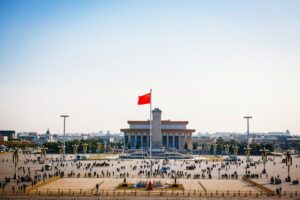The COVID-19 pandemic has put an increased strain on public finances in the UK, with the healthcare system, social welfare and job retention schemes all requiring major injections of funds not previously planned for. It is therefore expected that on top of already delayed projects, logistical difficulties, and temporary income shortfalls, the defence industry could experience significant cutbacks as government budgets are used for more demanding issues.
Since 2013 defence spending in the UK has steadily increased but as GDP looks set to fall in the wake of a recession, keeping the defence budget in line with previous years will be unlikely.1 Currently, the UK Ministry of Defence (MoD) receives a budget minimum of 2% of GDP in line with NATO recommendations.2 Ben Wallace, the Defence Secretary has sought assurances from the Chancellor that the current £41.5 billion budget will not be affected due to COVID-19 pressures but Rishi Sunak has made no promises. If national output shrinks by 10%, as experts predict, then this could cost the MoD around £4.15 billion alone without any direct ‘cuts’ being made. The Defence Secretary has pointed out that defence spending is not based on GDP going up and down, as projects require regular amounts of cash injection. Due to the UK’s close ties with NATO and their many operations abroad, it must maintain a level of defence funding regardless. Tobias Ellwood, Chairman of the Commons Defence Committee, has said that it would be irresponsible to cut defence budgets now saying: “Britain’s enemies were using the COVID-19 pandemic to rearm” even though all countries seem to be having to make similar financial reductions.
The European Commission is also expecting to make budget cuts on defence as the economic recovery fund for the EU starts to take precedence.3 The economic shockwaves of COVID-19 have forced EU ministers to prioritise spending for economic recovery over reducing military reliance on the US. The European Commission’s European Defence Fund (EDF), intended to promote cooperation on research and development of military equipment has just announced an income drop from an expected €11.5 to €8 billion.4 However, with the Military Mobility initiative budget also being reduced from €6.5 billion to €1.5 billion it looks like infrastructure commitments, such as constructing roads and bridges to transport troops, will fall on the domestic budgets of individual nation states.5 This places particular hardships on eastern European states in the event of a stand-off with Russia.
Turkey has raised concerns over its lack of military spending as it had already struggled in 2019 to maintain an effective budget with ongoing conflicts in northern Iraq and Syria, amidst high levels of unemployment at home.6 The Italian government too is in disagreement over its defence budget due to a looming economic crisis. There are also worries about a potential conflict of interest within Italy after they signed up for China’s Belt and Road initiative.7
Spain is becoming increasingly concerned that their main naval supplier Navantia will not be able to ride out the economic storm that COVID-19 has presented. They have called on the EU to increase its military spending through the EDF as a result, to provide a more collective solution. Navantia is Spain’s provider of frigates, aircraft carriers, submarines, patrol vessels, and logistic ships and has close ties with the UK. The company that manages Navantia finished with a loss of over €228 million in 2018 and have required state bailouts totalling €1 billion already pre-COVID-19.8 2020 was expected to be their rebound year and so the pandemic could not have come at a worse time. When the virus hit, only a third of their workers remained on-site to keep a skeleton crew to maintain minimum servicing and upkeep of machinery. With Spain already struggling to preserve defence budget targets, predictions are that they will have to make severe cutbacks on their military to maintain funding in other areas of the economy.
While not frequently advertised for security reasons, it would appear the virus has affected the military just as much as civilian life. Armed forces personnel are at risk of infection and social distancing presents new logistical challenges. Protecting them, therefore, amounts to protecting national security. Concerns have grown amongst officials in the American congress and the Pentagon about their military’s preparedness to mobilise an effective force during and after the COVID-19 pandemic outbreak.9 As a result, large scale military exercises have been cancelled with NATO countries in Europe. Recruitment has been slowed with training having to be redesigned to incorporate social distancing. Aircraft carriers deployed to the pacific have had cases of the virus and their navy is now working out how to test all of its sailors and how they might avoid their own pandemics given the lack of social distancing in those environments, with the ramifications on being operationally ready. One of the main issues the American Department of Defence has highlighted is supply chain vulnerabilities due to the pandemic.10 Small subcontractors have been hit particularly hard by social distancing and lockdown measures, without enough cash reserves to maintain viability if there is not a consistent throughput of business, having to rely on cash advances from primary contractors.
According to Michael O’Hanlon, a military specialist at the Brookings Institution: “The military might have to accept a lower level of readiness and incur more risk, at least temporarily.”11 The US Department of Defence estimates a three-month delay to schedules at a cost of billions of dollars. They will have to look to recoup some of the losses through a bailout or reallocate already previously approved funds. Studies also point to the delay in defence budget cuts when a financial crisis hits. The 2008 financial crash took years to fully affect defence budget spending and did not recover to pre-crisis levels for five years.12 However, the US Department of Defence has made it clear that China is at the top of their adversary list since the outbreak of COVID-19 and that operations in the Indo-Pacific area required fresh impetus.13 This could mean that certain areas of the US defence budget, depending on the threat risk, could actually see an increase in funds even during a recession. Even China has seen its defence budget increase at the lowest rate in percentage terms for thirty years, though it has pledged that its military will remain of a high importance. It is determined to maintain a robust navy in the South China Sea amid continued statements of preventing Taiwanese ‘independence’ after the US has just announced it has approved the sale of an additional 18 heavyweight torpedoes to Taiwan for $180 million. 14
Many developed countries such as the UK, US, Russia, France and Germany export high-value military hardware but with second and third echelon countries expected to seriously reduce investment in their armed forces, income levels will go down for the main military exporting countries.15 The Indian Department of Military Affairs has asked all of its armed forces to put on hold their capital acquisitions in anticipation of budget cuts due to the effect of COVID-19.16 The country needs to take stock of its expenditure as it is already committed to purchasing multiple different platforms from Russia, France and the US, putting a dent in its ambitions for escalation-dominance in South Asia.
In contrast, a recent report prepared by the Global Campaign on Military Spending pointed out that the $89 million being spent by the Pentagon to buy a single F-35 fighter jet, would fund 3,244 intensive care unit beds, and it wanted 3,000 of them.17 There is a great moral dilemma whether any country should be paying such huge sums to its military during such deep economic and social crisis as the world currently faces. Defence spending comes into direct conflict with other public sector spending such as healthcare. However, this pandemic has brought to the forefront a notion: ‘should supporting societal resilience become a greater military task’.18 Should keeping a population safe actually extend to helping society pay for certain types of medical equipment, such as ventilators, out of the military budget? Given that a virus has brought people’s lives to a standstill and detrimentally affected countries’ economies as much as any war might. Should monies therefore not be redistributed from defence budgets but through them to ensure a better run defence contingency in the event of a similar outbreak in the future.
The military’s ability to act as first responders in a time of crisis could pave the way for more military integration into society to act as either support or as a perceptive deterrent. Troops on streets could offer more logistical help rather than just a contingency for civil unrest. EU officials have said that risks have not gone away because of COVID-19 and that the military could help provide specific bio-warfare knowledge such as hi-tech resistant clothing and ‘crisis response mechanisms’.19 The EU’s Chief Diplomat, Joseph Borell, thinks that COVID-19 has actually “brought a new threat” that requires stronger EU defence strategies to combat it. It seems there is now an increased requirement for a different type of military in the face of differing threats.
Threat perception, generally as a result of competition between the main powers or an extreme act of terrorism, such as the attack on the World Trade Centre in 2001, seems to be the only thing likely to get defence budgets back to pre-COVID-19 levels. Experts think that, in light of this pandemic, military roles should be re-examined and that ‘supporting societal resilience’ should be a greater military priority.20 An economic downturn and an impending Brexit may actually now offer the UK’s MoD the opportunity to procure projects both from locally based firms and at value for money.21 The UK is still under EU competition restrictions until 31st December 2020.
If countries want to maintain any form of geopolitical credibility, they then need to think of ways of maintaining their military proficiency through cost-effective strategies. While COVID-19 was not a biological attack on a specific nation and was seen as more of a civilian threat it still represented a danger to public safety and raised pertinent security questions. With this in mind, it is unlikely that many countries most affected by COVID-19 can maintain defence budgets over the short term and therefore an effective deterrent to whatever security risks a post-COVID-19 world may hold. Conversely, countries that seem to have coped relatively well may see the current pandemic as an opportunity to assert their military dominance on the world stage.


